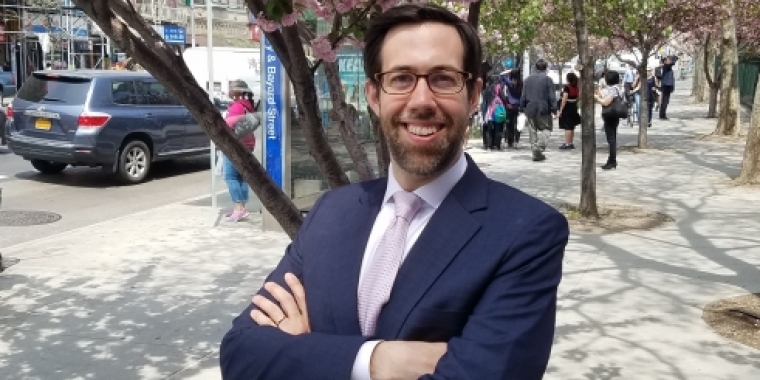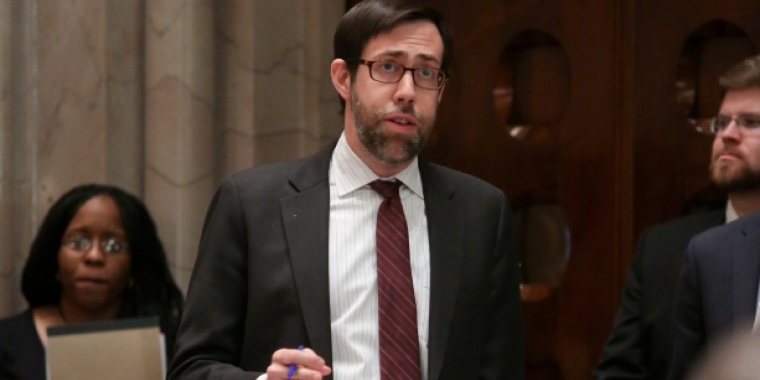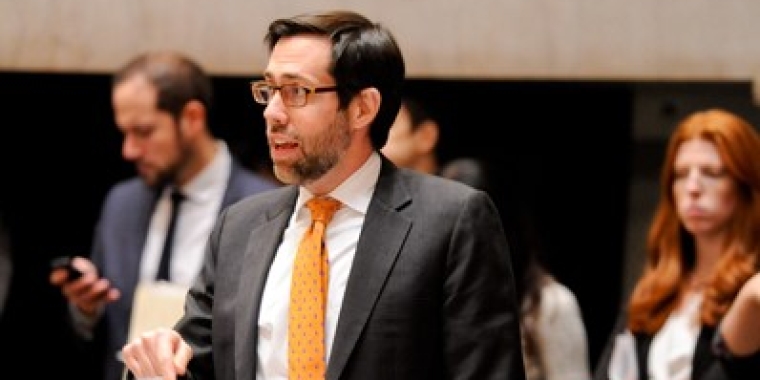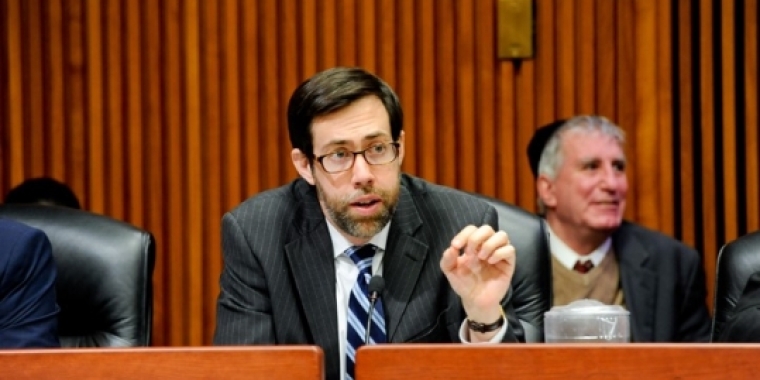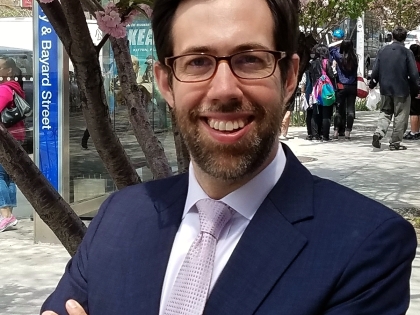
Senator Squadron Testimony on Proposed Modifications to the Brooklyn Bridge Park General Project Plan
Daniel L. Squadron
July 30, 2015
-
ISSUE:
- Historical Preservation
- ESDC (Empire State Development Corporation)
- New York City
- Constituents Corner
Squadron Urges ESDC to Reject Modifications, Consider Community Impact, Seek Alternatives
BROOKLYN -- Today, Senator Daniel Squadron submitted testimony at the public hearing regarding the proposed modifications to the Brooklyn Bridge Park General Project Plan, convened by the Empire State Development Corporation Board and Brooklyn Bridge Park Development Corporation Board. Squadron’s prepared testimony is below, and attached aresupplemental documents submitted to the boards.
I. Introduction
My name is Daniel Squadron, and I represent the 26th District in the New York State Senate. My district includes all of Brooklyn Bridge Park, as well as the Brooklyn neighborhoods of Greenpoint, Williamsburg, Vinegar Hill, DUMBO, Fulton Ferry, Brooklyn Heights, Cobble Hill, and Carroll Gardens and the Manhattan neighborhoods of Tribeca, Battery Park City, the Lower East Side, Chinatown, the Financial District, Greenwich Village, Little Italy, SoHo and the East Village.
Thank you to the Empire State Development Board and Brooklyn Bridge Park Development Corporation Board for the opportunity to provide testimony. I urge the board to reject the proposed modifications, require a new Environmental Impact Statement (EIS) for the Pier 6 sites, and consider alternatives.
As many of you know, I have been a long-time supporter of ensuring Brooklyn Bridge Park is completed and has adequate funding. We agree that this must not be in doubt. I have always opposed housing in Brooklyn Bridge Park. At Pier 6, this is a position that has been taken by every local elected official surrounding the area, including the Congressmember, current and former Assemblymember, and both City Councilmembers (see highlights in attachments 1-3). In addition, the Pier 6 proposal is opposed by every civic association representing the area surrounding the park. Concerns have also been raised by the City Comptroller, Public Advocate, Community Board 2, and Community Board 6.
It is important to note that broad opposition to luxury housing at Pier 6 has existed for years, long before the potential addition of affordable housing. The luxury-housing funding model perpetuates imbalances in park access and decision-making, and is inconsistent with the principle of open space that is protected, owned and maintained by the public, and democratically accessible to all. This is one reason that I urge the Boards to reject the proposed amendments and push for alternatives.
Separate and apart from the above concerns, there are sufficient reasons to reject the proposed modifications, consider alternatives, require a new EIS, and reject the park staff’s request to rush forward.
Specifically, in the decade since the last EIS, we have seen material differences in the areas surrounding the proposed Pier 6 developments. These include modified flood zones, significant -- and unanticipated -- proposed development at the nearby Long Island College Hospital (LICH) site, a local school overcrowding crisis, increased need for open space, a more crowded transportation network, changing neighborhood character, and additional construction impacts. Though the 2014 Technical Memo references some of these issues, these material differences make approval of the modifications inappropriate.
II. Existing Conditions – Public Policy & Waterfront Revitalization
The Technical Memo fails to substantively consider the change in flood zone conditions at the site. Since the 2005 FEIS, there has been a significant increase in flood risk at the Pier 6 sites, according to 2015 preliminary Federal Emergency Management Agency flood hazard maps, from a 0.2% annual flood hazard zone to a 1% zone. I represent Lower Manhattan and the Lower East Side, as well as the Brooklyn waterfront, and saw the severe effects of Hurricane Sandy across my district. Considering the risks, deeper evaluation of the impact of these changes, and compliance with applicable codes, is necessary.
III. Existing Conditions – The Future Without the Proposed Project
The Tech Memo erroneously suggests that “residential development has continued in the study area, generally consistent with trends identified in the 2005 FEIS.” (pp. 9-10). This framing alone merits new analysis.
Among the many unanticipated changes in the local area since the 2005 FEIS, perhaps the most consequential is the significant increase in development, particularly the proposed development at the LICH site, which is effectively across the street. As reported in the Brooklyn Eagle and Brooklyn Paper on May 19th, developers at the LICH site have presented a four tower as-of-right development option, with buildings up to 44 stories. It has been estimated that this would create approximately 400 residential units. The developer has also put forward a rezoning proposal that includes four towers with a height of up to 40 stories. This is estimated to introduce 820 new residential units. This 1.12 million square feet of potential new residential development was not taken into account in the FEIS and was not adequately considered in the Tech Memo. The Memo estimates significantly fewer square feet of new residential development than the project’s rezoning proposal for this project. This is in addition to the 36 story tower proposed at the Brooklyn Heights Library, currently estimated to include an additional 139 residential units, which was also not anticipated.
Approving these modifications would not only prevent a new EIS, it would also mean that the project at Pier 6 will proceed ahead of the LICH site, without any knowledge of the overall impact on the community of these new developments.
IV. Community Facilities And Services; Public Schools
Though the number of units at the Pier 6 project alone does not trigger CEQR health care facility analysis requirements, it is important to note that the closure of LICH has a major impact on healthcare in the immediate area. Certainly the elimination of the local full-service hospital was not contemplated when this plan was conceived, and its impact has not been analyzed. It should be.
Local elementary school overcrowding is also not adequately considered in the Technical Memo. According to the Memo, the proposed project would be likely to increase elementary school overcrowding from 140.59% to 144.33%, based on capacity utilization spread among 8 different schools (CEC 13 Sub-District 2). This 8-school impact is under the 5% threshold for a change that CEQR defines as a “significant adverse impact.”
But, the entire Pier 6 project is in the Public School 8 (PS 8) zone. Of approximately 200 PS 8 kindergarten applicants this year, about 50 were waitlisted. The 125 additional students the Memo acknowledges the Pier 6 project would generate would increase enrollment in the PS 8 zone by over 14%. In fact, all of the Park’s residential development is in the PS 8 zone, meaning that already-approved residential development related to the General Project Plan at Pier 1, Pier 6, and John Street will contribute to PS 8’s overcrowding crisis. If considering the 8 school Sub-District, it is also important to consider the overall impact on schools of the entire GPP.
To date, the Department of Education (DOE) has not proposed additional elementary school capacity in the area. In fact, DOE has yet to present any substantive plan to address this overcrowding crisis at all. On behalf of these 8 schools, I strongly urge you not to approve a modification to the General Project Plan that does not consider and address the impact on overcrowded public schools.
V. Open Space
The Technical Memo acknowledges that the Pier 6 development would decrease open space ratios, though less than the 5% threshold to require more in-depth study. It is perverse that the same standard for open space ratios is applied to this GPP, which exists to increase open space, as to other types of project, like housing or schools. But that speaks to a deeper incoherence suffered by the proposal before you. Is this General Project Plan’s goal to build open space? Or to achieve other goals?
VI. Transportation
Since the 2005 FEIS, overall subway ridership has increased approximately 21%. Since 2009 -- the earliest year for which individual station data is publicly available -- the Jay St-Metrotech and Bergen stations have had ridership increases of 17.79% and 14.94%, respectively, both greater than the system-wide increase in that six year period. The Memo does not note this changed condition. The Memo also does not consider the anticipated Brooklyn-Queens Expressway rehabilitation project. Though details have yet to be announced, the project would have significant impacts on local traffic, and space availability.
Park attendance has also been significantly higher than expected, which impacts analysis of transportation and traffic. The Brooklyn Bridge Park Conservancy’s informal analysis of park visitors found summer averages of 119,000 weekend visitors, and weekday averages of 24,539 in 2014. This is significantly higher than the Trip Generation Characteristics EIS addendum, which anticipated approximately 22,500 weekend visitors and 7,500 weekday visitors (cutting EIS trip generation estimates in half to account for return trips).
In 2005, the increase in transit use and the popularity of the park were not anticipated. It is great news that the park’s popularity has wildly outstripped expectations. But, as a result, it is critical that impacts are fully considered.
VII. Neighborhood Character
When the Pier 6 plan is viewed in context of development and other changes throughout the neighborhood, it clearly exacerbates the rapid disruptions happening locally. The neighborhood’s changes are not being driven by thoughtful urban planning, but rather by real estate values that would have been considered laughable in 2005. The Memo argues that the plan does not impact neighborhood character. However, when considered alongside the LICH development (literally), PS 8 waitlists, and other rapid changes, all of which are contemplated in isolation, it is impossible to argue that these developments do not have a collective impact on neighborhood character. (For example: this project would be the tallest building on the Brooklyn waterfront from Red Hook to North Williamsburg.)
Additionally, the Memo fails to note that every local elected official and civic association that represents the area opposes the proposal put forward by park staff, a significant change from 2005 and evidence of the plan’s impact on neighborhood character.
VIII. Construction Impacts
The 2005 FEIS contemplated construction of parkland and development parcels to generally occur contemporaneously. It also projected full project completion by 2012. The FEIS did not anticipate substantial residential construction occurring at the Pier 6 site separately after the park was built. The Technical Memo does not adequately evaluate this change. Additionally, it assumes weekday-only construction even though other development projects in the park, including those at Pier 1, have sought weekend construction variances.
Though the Technical Memo does note some of the significant potential development at the LICH site, it fails to acknowledge construction of this development in contemplating the Pier 6 project’s construction impacts. It is all too likely that construction at LICH, whether as-of-right or through a rezoning, will overlap with construction at the Pier 6 sites. Given the proximity of the two sites, this dual impact must be considered.
IX. Alternatives
Many, including the City Comptroller, have raised concerns about the Park Corporation’s financial transparency. Though there has been significant and unprecedented growth in the residential market since the plan’s original formulation, little in the plan has substantively changed. In our increasingly expensive real estate market, it is bizarre that the assumptions made a decade ago about revenue seem to continue to guide today’s decisions about the size and need for housing, when in fact revenue projections from development have increased substantially.
Financial projections included in the FEIS estimated one-time revenues at approximately $41.5 million, versus $94.9 million in one-time revenue (scaled to 2005 dollars) now projected from the development according to the Corporation. Additionally, the FEIS estimated a $27.8 million present value of recurring revenue based on a 20 year time period at a 7% discount rate; the Corporation’s most recent projections for recurring revenue have a present value figure of $21.7 million (also scaled for inflation). Combined, this is an overall increase from $69.3 to $116.6 million (2005 dollars), or 68.25%. This does not include increased assessments, ground rents, and payments at the Park’s other development sites.
The park staff, whose eagerness to develop Pier 6 is evident, has presented financial projections that show funds from Pier 6 are only needed in the mid-term, with revenue exceeding need (and being redirected to the city) in the long-term. However, there has been no independent consideration of the best way to meet the park’s financial needs, nor any independent analysis of the what those needs are.
The “independent” financial analysis released publicly, today coincidentally, is certainly the kind of analysis that the Corporation should be conducting internally. But, it is not by any means a comprehensive “independent” analysis. Though it notes that “members of the community, the BBP Board of Directors, and local elected officials have asked that a third party review the analysis and provide research support for the model,” I am unaware of elected officials or community members who were consulted in the report’s formulation. It is clear that the staff supports this model and believes it is needed, and it is clear that this urgency was shared with the “independent” consultant hired by the Corporation to analyze their finances. For example, the report notes, "I understand from BBP that borrowing is not a realistic option because it poses both legal as well as policy challenges..." A report generated in partnership with the park’s staff by a consultant working with the park’s staff is certainly an important step toward the internal analysis the Corporation should employ, but it is by no means “independent.”
There is no doubt that there are alternatives worth considering.
For example, the challenge presented by mid-term deficits and long-term surpluses related to capital investment is often ripe for borrowing, bonding or developing partnerships. Is that appropriate here? Or, could the park be financed with a Park Increment Recapture (PIRC), as I proposed in 2009, through which the City would redirect a percentage of increased property tax assessments on rezoned or newly taxed properties near the park (like LICH, the Brooklyn Heights Library, and former Watchtower properties) to the park?
X. Additional Concerns
Preceding discussion of the Pier 6 project, the proposed modification inserts the phrase, “without regard to Project finances.” There is community concern that this language is an effort to roll back the long-held promise to the community that there will be the minimum amount of luxury development required to maintain the park's long-term fiscal health. Any change to this long-held principle would be unacceptable. The lack of clarity on this issues is further evidence that the plan warrants a significantly longer and broader conversation, informed by a new EIS and more substantive public consideration of plan alternatives.
There is also concern about the ability of the park Board, a majority of whom are City-appointed, to conduct independent due diligence on alternatives. In the 5 years since its formation, the BBP Board has not rejected or significantly modified a staff recommendation at a meeting. Further, the Board prohibits individual board members from making motions. Rather, all agenda items are solely at the Chair’s discretion. Additionally, public comment is only heard after votes occur, and is no longer responded to by either the Board or staff. Since the Board adopts staff recommendations without modification and has procedural rules that make it difficult for board members to substantively impact the process, ESD and BBPDC should reject these modifications and consider alternatives.
XI. Conclusion
I have long opposed housing in the park because of the impact on park access and decision-making perpetuated by funding from a luxury-housing model.
Let’s be clear: the addition of some affordable housing (high-income though it is), a pre-kindergarten site, prevailing wage jobs, and real height caps are an improvement over the other development the park has pursued.
Though these changes are welcome, the way that supporters of luxury housing have used them to bludgeon opponents of luxury housing is not. Unfortunately, it is the inevitable conclusion of a policy that effectively pits open space against affordable housing, and against pre-k. All of these are vaunted goals. All of them are welcome and necessary in this community, and should exist in every community.
But, government at all levels is faced with difficult choices as it allocates scarce resources. Among all of these important needs, parks almost never come out on top. The tone of this debate is a stark reminder of that. It’s too bad.
In the past, debate about the park has had a lasting positive impact on the park. The work that my colleagues and I did to delay and reduce housing also created or accelerated the Pop Up Pool, the Squibb Park Bridge, the skating rink, and Pier 2. Perhaps ESD and BBPC can work with us to ensure this debate ends well too.
Finally, I would like to respectfully point out that this process -- the mid-summer modification hearing, the park staff’s insistence on recommending a developer it is not authorized to select, the general rush to build, the last minute release of an “independent” financial analysis -- suggest an urgency that is not supported by the facts. The park is not facing a crisis in its operating budget. The rights on the Pier 6 sites will not expire. The urgency seems more a matter of politics than one of policy.
Too many questions are unanswered, alternatives unexplored, and claims unproven to approve this proposal.
I urge ESD and BBPDC to disapprove of these modifications, require further environmental study such as a new Environmental Impact Statement for the Pier 6 project, and ensure substantive consideration of alternatives to this outdated luxury housing plan.
Thank you to the Empire State Development Board and Brooklyn Bridge Park Development Corporation Board for the opportunity to provide testimony today.
